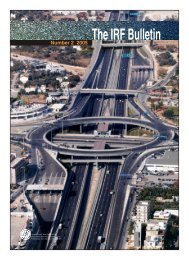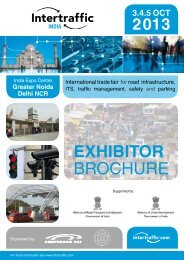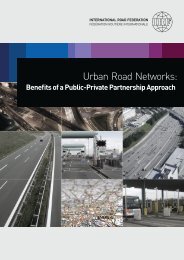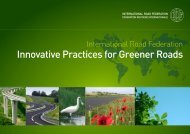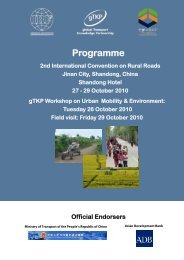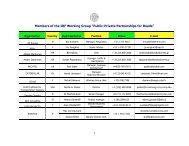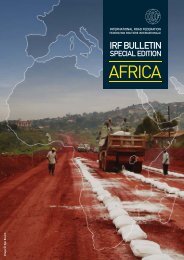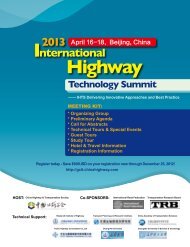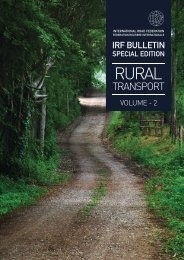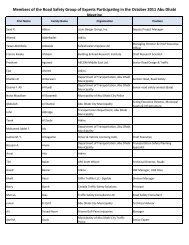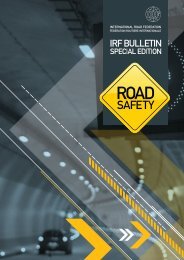Download - IRF | International Road Federation
Download - IRF | International Road Federation
Download - IRF | International Road Federation
You also want an ePaper? Increase the reach of your titles
YUMPU automatically turns print PDFs into web optimized ePapers that Google loves.
TRANS-NATIONAL HIGHWAYS AND NATIONAL PROGRAMMES<br />
Developing Euro-Asian<br />
Transport Links<br />
Michalis P. Adamantiadis<br />
Chief, Transport Facilitation & Economics<br />
Section, Transport Division, United Nations<br />
Economic Commission for Europe (UNECE)<br />
from the countries concerned identified the main Euro-<br />
Asian road and rail routes to be considered for priority<br />
development as well as the main transhipment points and<br />
ports along them<br />
Globalisation has led to significant increases in trade and<br />
transport between Asia and Europe. Most of the cargo<br />
traffic has chosen increasingly congested - but still the<br />
least costly - maritime routes, pointing to the need to<br />
further develop and promote inland Euro-Asian transport<br />
links. These routes, once established, could provide<br />
credible and competitive transport options for traders<br />
and shippers. They could also become an effective tool<br />
for stimulating economic development and integration of<br />
the Euro-Asian region, including landlocked countries of<br />
Central Asia.<br />
But, for historical and economic reasons, transport links<br />
in many countries along the traditional Silk <strong>Road</strong> are<br />
insufficiently developed. The persistence of non-physical<br />
bottlenecks, such as cumbersome, costly and timeconsuming<br />
border crossing procedures, excessive<br />
documentation requirements, unofficial payments, and<br />
unexpected closures of borders, together with<br />
inadequate transport infrastructure, discourage transport<br />
1<br />
operators from using Euro-Asian inland transport routes.<br />
The UNECE started in 1995 to address this issue. In 2000<br />
and 2002 the UNECE road and rail infrastructure<br />
agreements were extended, to incorporate the Caucasus<br />
and Central Asian links. It also developed, together with<br />
ESCAP, a common strategic vision for the development of<br />
Euro-Asian links.<br />
The greatest progress has been achieved since 2003,<br />
when UNECE and UNESCAP began to promote<br />
cooperation among the countries directly concerned. All<br />
East-European ECE countries that were not EU members<br />
at that time, Caucasus and Central Asian member<br />
countries, and other interested ESCAP members,<br />
including China, were invited to participate.<br />
In four Expert Group meetings (from 2003 to 2007)<br />
organized under Phase I of the Euro-Asian Transport<br />
Linkages (EATL) Project, Government representatives<br />
In this project, 230 investment opportunities worth USD<br />
43 billion, have been evaluated and prioritized, using a<br />
methodology similar to that of the Trans-European<br />
Motorway (TEM) and Trans-European Railway (TER)<br />
Projects' Master Plan. Around half the projects have<br />
secured financing and are likely to be implemented in the<br />
medium term.<br />
Non-physical obstacles, which constitute a major barrier<br />
to Euro-Asian transport, have also been addressed in the<br />
context of this project. Capacity-building workshops on<br />
the facilitation of international transport along Euro-Asian<br />
transport links were organized in Azerbaijan, Belarus,<br />
Georgia, Kyrgyzstan, Moldova and Ukraine.<br />
The first phase of the United Nations EATL project<br />
culminated in February 2008 with the ministerial meeting<br />
in Geneva. During that meeting, transport ministers and<br />
<strong>IRF</strong> BULLETIN SPECIAL EDITION : ASIA & OCEANIA<br />
06



